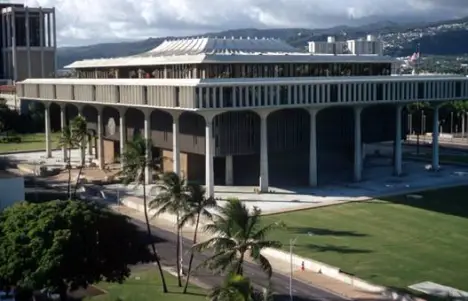The conference meeting to negotiate differences in the state budget between the House and Senate was held a week earlier than normal to allow more discussion time for conference members and avoid the last minute rush to act on other fiscal bills.
In his opening remarks today, Senate Ways and Means Chair, David Ige said, “This is an historic convening of the conference committee. I cannot ever remember beginning this early in the session on the budget. I would like to commend the House for its quick action and work in passing the budget over to the Senate early, and the Senate was inspired to do likewise.”
House Finance Chair, Sylvia Luke acknowledged the leadership of Senate President Donna Mercado Kim and House Speaker Joseph M. Souki “in making it possible for us to start the conference meetings early.” Luke added, “Today we are not only ready to officially open conference meetings, we are ready to make significant decisions.”
Of the thousands of budget items facing the conference committee, two-thirds of them have already been agreed between what was contained in the House and Senate drafts of the budget.
Today, the chairs agreed to appropriate $100 million for fiscal Year (FY) 2014 and $117.4 million for FY2015 to begin payments on the unfunded liabilities. Currently, the unfunded liabilities for the Employer-Union Health Benefits Trust Fund is $13.6 billion.
“We believe that paying down the State’s unfunded liabilities must be a priority and can no longer be left to discretion,” said Senator Ige. “Additionally, this will put the State at the leading edge of national efforts to address this issue.”
Also today, the committee agreed on appropriating about $1.2 million each year to the Charter School Commission. This appropriation would add 15 positions.
“We both agreed to fully fund the Charter School Commission to ensure that they do have the resources to conduct the audits, to establish the performance contracts, to really do the public’s business to ensure that the public charter schools are capable of providing quality educational services to our children,” said Representative Luke.
The two sides also resolved differences on four other items today.
- An allocation of $1 million to sustain the Hawaii Health Information Exchange (HHIE) contract for FY14. The HHIE is a local non-profit organization designated by the State of Hawaii to build the statewide health information exchange, a secure electronic network that allows health care providers to transmit patient medical information more efficiently.
- Protection against invasive species by providing $750,000 in each of the next two years for the Hawaii Invasive Species Council. These funds will support a wide variety of invasive species prevention, control, and outreach projects across the state.
- $4.7 million over the next biennium for risk management ensuring the state is adequately protected against catastrophic losses.
- $700,000 for FY14 for the State Library System to purchase additional books, e-books, and other circulatory materials statewide.
Additionally, Ige and Luke highlighted some of the other notable budget items upon which there was agreement in the House and Senate budget drafts.
- $1.2 million in special funds over the next biennium to fund seven new positions, including environmental health specialists and engineers. These positions will monitor watershed and surface water quality, the state water reuse and green house gas program, air pollution control programs and the enforcement of clean water regulations.
- Approval of $126,400 for two juvenile parole officer positions on the neighbor islands which will help keep youth with their families instead of requiring them to relocate to the Oahu Youth Facility.
- $135,000 to fund three animal disease inspector positions that will assist in controlling livestock diseases.
- An appropriation of $327,000 over the next two years for the Automated Fingerprint Identification System and Facial Recognition System maintenance. This will enable all county law enforcement agencies to keep their systems running 24-hours 7-days a week.
- $100,000 in general funds and $225,000 in federal funds to upgrade 120 emergency sirens around the state.
- Support for veteran services by providing $870,000 for the next two years for five new counselor positions, burial service support, special housing for disabled veterans, and program operations.
- $456,000 each year in federal funds for domestic violence prevention and support services.
- An increase in the special fund ceiling by over $700,000 for eight new food sanitation inspector positions to address an increasing number of food safety violations on Oahu.
- Over $2.2 million for both years to restore 32 custodial positions for the maintenance and upkeep of Honolulu International Airport. As the first and last place that visitors will see during their trip, it is important to create a pleasant impression for all visitors to Hawaii.
- Nearly $81 million in FY14 for the repair and maintenance of our state highways.
The conference committee is scheduled to meet tomorrow, Friday, April 12 in conference room 309 at 2:30 p.m.
Filed under: Announcements, Environment, Hawaii, Legal, Legislature, Rumors, State Affairs | Tagged: Charter school, Facial recognition system, Hawaii | Leave a comment »






















